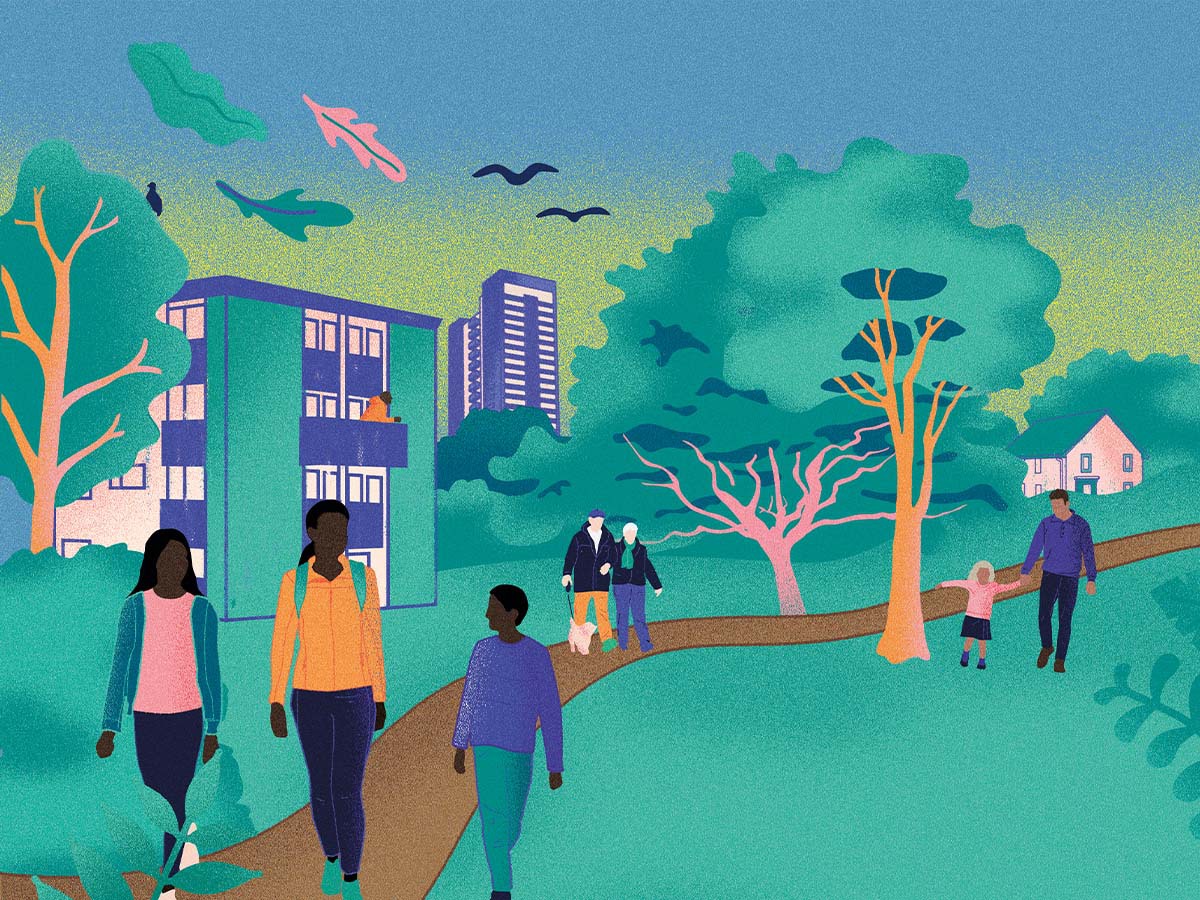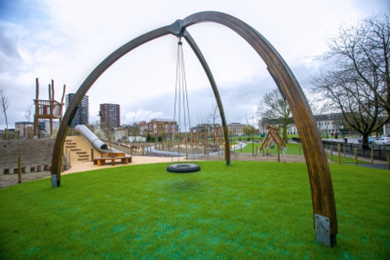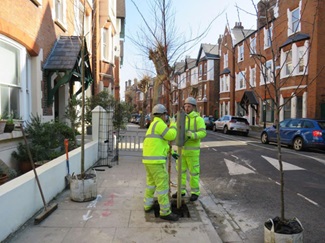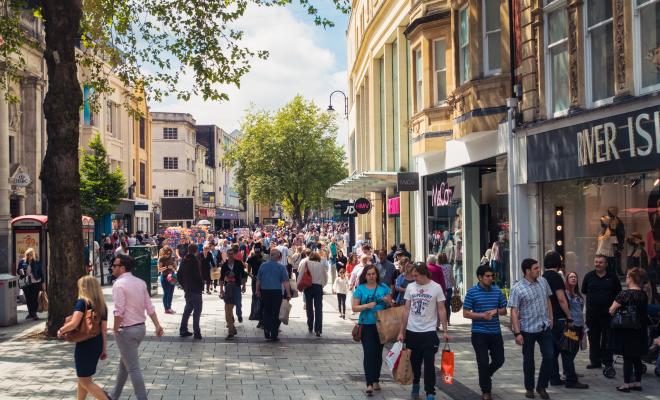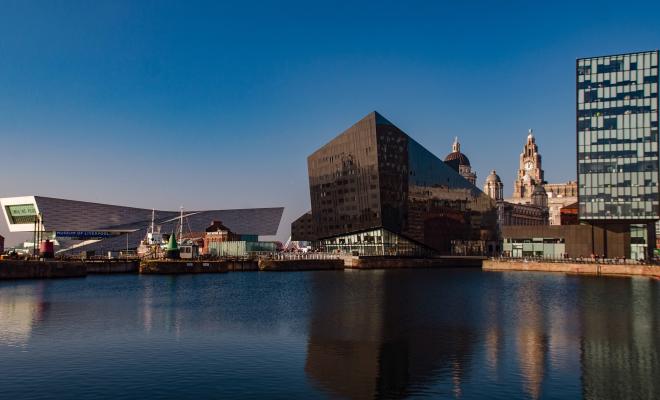20 Sep 2024
How are Actions 46 and 48 tackling the climate crisis?
In urban areas, nature-rich green spaces help to draw down carbon pollution from the atmosphere, as well as contribute to people’s wellbeing. Yet in many areas, green space is being lost and access to green space varies considerably.
Access to nature is also an issue of racial justice. Friends of the Earth research found that people of colour are twice as likely as White people to live in areas of England that are most deprived of green space.
In Hackney, about three-quarters of residents don't have access to a private garden, making access to public green spaces even more important. Hackney Council is now building on efforts over more than a decade to make green spaces available to everyone, regardless of background, particularly the many Hackney residents who live in rented accommodation and on estates.
Hackney’s 283 hectares of green space includes 58 parks and provides roughly 15 m2 of green space per resident. As of 2023, 29 of Hackney’s parks have a Green Flag Award, an accreditation that recognises well-managed green spaces.
However, with some neighbourhoods still deprived of green space, the council recognised that there’s still work to do.
From the introduction of street trees, parklets and green corridors to major park restoration projects and the creation of entirely new open spaces, access to nature is now a central consideration in the council’s Roadmap to Net Zero, and also the subject of a new strategy.
The council’s Parks and Green Spaces Strategy 2021-2031 was adopted in May 2021 following a community consultation with focus groups and over 50 meetings. Based on what residents told the council, it sets out how Hackney will continue to improve its parks and green spaces over the coming decade. Its 30 commitments include:
- Increasing biodiversity.
- Appointing a Volunteering Officer to oversee a comprehensive volunteering programme across Hackney’s green spaces.
- Exploring the creation of a non-profit organisation, Hackney Parks and Green Spaces Foundation, to help raise more funds.
- Developing an apprenticeship and work experience programme linked to green space conservation, accessible to disabled people and people with special educational needs.
- Making it easier for community and cultural events to be hosted in parks.
- Introducing 3 new food growing projects on housing estates every year.
The council has also made a separate commitment to plant over 5,000 new street trees between 2018 and the end of 2022 (which it has achieved and exceeded at a total of 5,834), plus over 12,000 new trees and saplings in Hackney’s parks and open spaces. This will eventually yield an increase in canopy cover in Hackney from 20% to 30%. Alongside this, the council is starting to trial the use of electric tools and machinery to lower the carbon emissions of managing its green spaces and has committed to annual reports to update residents on progress towards its commitments.
Improving access to existing green space
Although there's a high number of parks in the borough, many date from the Victorian era and need improvements. Some are fenced off, and these green spaces aren't well connected to the surrounding environment. The council wants to open up these older parks and make them more inviting.
Restoring green spaces for people and nature
Currently, Shoreditch, Dalston and Haggerston are the areas of Hackney that offer the least access to green space, with far fewer private gardens than elsewhere in the borough. Four major projects are already underway:
- Abney Park redevelopment. This project has seen a community hub and café being built, and the 1840s chapel completely renovated. The council has partnered with the charity Possible to install a ground-source heat pump to sustainably heat Abney Park’s buildings. This is accompanied by educational outreach to inform residents about how heat pumps work. The park has unique historic value, as it's the resting place of many local anti-slavery campaigners. The redevelopment therefore combines greening with heritage conservation.
- Fairchild’s Garden. This is a dark and disused park surrounded by a large wall and with a narrow gate. This park has been completely transformed and will be opened to the public in 2024. The renovation integrates spaces for socialising and new plants to celebrate Thomas Fairchild, the famous horticulturalist after whom the garden was named.
- London Fields and Hackney Marshes. In 2023 Hackney received 2 grants from the Mayor of London’s Grow Back Greener Fund to promote nature restoration and biodiversity in these 2 well-loved green spaces. Areas of London Fields have been rewilded, with improvements to woodland and new habitats created around the edges of the park. A new wildlife-rich area has been introduced to Hackney Marshes. Volunteers, parks users, groups and local ecologists have led on both projects.
- West Reservoir. This watersports centre, owned by the council, will be opened to the public for the first time in 2024/25. To improve habitat in and around the reservoir, new reed beds, wildflowers, trees and hedges have been planted.
“We want the very best parks for our residents – many of whom don’t have green space of their own – so we’re committed to making sure they’re beautiful, biodiverse, accessible and have lots of facilities for all of our residents to enjoy.”
Caroline Woodley, Mayor of Hackney
Creating new green spaces
Using planning policies
Hackney Council is using its Local Plan (policies LP46 through to LP52) to make sure developers are protecting and enhancing green spaces. For example, all developments with roofing over 100 m2 are required to be "living roofs," and these are encouraged on smaller developments too. Another policy requires proposals for 10 or more residential units to maximise on-site provision of open communal space at 14 m2 per person.
Hackney’s Child-Friendly Places Supplementary Planning Document sits alongside the Local Plan. It defines a "child-friendly" urban built environment as one that includes opportunities for children and young people to access nature in safe and unpolluted urban spaces, a definition in line with the UN Convention on the Rights of the Child. This document demonstrates Hackney’s joined-up approach to green space, linking the benefits for nature and people.
In spring 2023 Hackney Council approved its Green Infrastructure Strategy, which is informed by and builds upon policies in the Local Plan as well as other council strategies, such as the Transport Strategy.
Creating parklets
In 2018 the council launched the Community Parklet Scheme. A parklet reclaims space used for parking vehicles on residential streets and replaces it with seating and planted beds, or other uses suggested by residents. Parklets give residents a place to meet, play and socialise, and create a calmer, greener street for all. Ten were installed by the end of 2021. Building on this, in 2022 residents were invited to submit their own designs for new parklets, with more installed throughout 2023.
Hackney has also trialled several low traffic neighbourhoods on a temporary basis, with greening measures such as trees and pollinator-friendly planting planned if they're made permanent. The council is also closing some roads that bisect parks and turning them into permanent green spaces. Hackney’s ultimate aim is to make 75% of the borough “low traffic,” which will entail dozens more greened streets.
UK’s first Postcode Gardener
In 2018 Friends of the Earth partnered with Hackney Council and the residents of Daubeney Road for a pilot project. The UK’s very first "Postcode Gardener" spent 350 hours organising and advising residents on how to transform their road into a mini green haven. Following Hackney’s success, Postcode Gardeners are now springing up across various communities. Friends of the Earth has partnered with The Co-operative Bank to transform over 1,000 nature-deprived spaces over the next 2 years. Find out more about our Postcode Gardener programme.
Hackney’s focus on improving green spaces has a series of success stories and has been well received by residents. 96% of people surveyed by the council said they liked or loved Hackney’s parks and green spaces. This is a popular policy area in which the council has a positive reputation.
What impact has the project had?
Parks restored
In 2011 the authority invested £8.9 million in the restoration of Clissold Park, which is now well used and valued by local people.
In 2019 Daubeney Fields play area reopened after major improvements. The once underused park saw an increase in visits from 27,000 between July and December 2018 to 43,000 for the same period in 2019.
In 2021 Springfield Park opened after a restoration costing more than £3 million. Across Springfield Park and Daubeney Fields, 101 Japanese cherry trees were planted –part of an overall gift of 6,500 trees donated to the UK by Japan.
In April 2023 the £2 million restoration of Shoreditch Park was completed and opened to the public. Over 1,900 people took part in public consultations on the design of the park, which features a new playground, welfare facilities, cycle storage and multi-faith facilities. The council predicts a significant net gain in biodiversity and contribution towards climate resilience with rain gardens, wildflower meadows and 72 new trees to be planted.
The London Natural Capital Account calculates that Hackney’s parks provide health and economic benefits valued at £646 per person in the borough every year. That's a benefit cost ratio of 1:36.
Wider benefits of greening outside of parks
As a result of the Postcode Gardener project, there's a greener route for pedestrians and cyclists between Daubeney Fields and Hackney Marshes. There were social benefits too as people interacted with their neighbours, especially families and children, because the local primary school was strongly involved.
What made this work?
Recognising the co-benefits
- Social benefits. Having regular, easy access to green spaces is linked to improved mental wellbeing, reduced stress and better community cohesion. Hackney residents said access to nature was really important to their physical and mental health, something that's now recognised by Hackney’s strategy.
- Climate adaptation. Green spaces make neighbourhoods more resilient to climate change by helping to reduce extreme heat and absorbing run-off water to lower flood risk. For example, Hackney installed a small 55 m2 rain garden to connect 2 sections of Ufton Gardens, improving accessibility and flood resilience simultaneously.
Working with communities
This is at the heart of the Parks and Green Spaces Strategy, which was written with input from the Hackney Youth Parliament. To produce the strategy, over 50 stakeholder meetings were held including with community organisations, public health experts, older, young and disabled people, conservationists, planners, housing owners, NHS employees, and park users’ groups.
Listening to communities, and ensuring they're invested in the actions in the strategy and have a sense of ownership over their local green spaces, is crucial. They're the ones who use parks most and know them best. Examples of engaged groups and sections of the community are:
- The Tree Musketeers, a group of volunteers who plant and care for trees in Hackney, and who've run their own tree nursery since 2000. The Musketeers work closely with the council and were involved in the cherry tree planting in Springfield Park and Daubeney Fields Park.
- Park trusts and users’ groups, which exist for individual parks across the borough. The Kynaston Gardens User Group, for example, fundraised to regenerate the park, also reaching out to the council. Together, they brought the park back to life.
- Clapton Girls Academy, which participated in a park design workshop and visit to Millfields Park to offer comments on how to make green spaces safer for women and girls, one of the strategy’s commitments.
“When we bring in new volunteers, we emphasise the fact that it’s good to be outdoors doing physical work with trees, gardening, working with the bees or whatever it is. It’s really good for you – it's sociable and good for your mental health.”
Christine Kings, Chair of Hackney Tree Musketeers
A smart approach to bidding
Successful funding bids require significant commitment of staff time to secure and a commitment to deliver if the funding is secured. Hackney ensures that funding bids align with its wider goals and what the Parks Development team wants to achieve as a service. For instance, at Abney Park a development board of stakeholders met for over a year to agree a vision before applying for funding. Putting the vision before the funding makes Hackney’s bids more effective.
What resources were needed?
Between 2010 and 2023, Hackney has invested £33 million in parks and green spaces.
Typically, major park restoration projects in the borough are part-funded by a grant from an external source, with a match funding contribution from the council itself. The varied funding sources drawn on by the council include the National Lottery Heritage Fund’s Urban Parks Programme, the London Marathon Charitable Trust, the Veolia Environmental Trust, Nesta, National Grid, and the Historic Houses Foundation. Section 106 funding (money from developers to improve nearby areas) has also been utilised.
The council’s Parks Development Team has recently grown from 3 to 5 staff. Funding from the National Lottery has supported 2 temporary site manager posts for the Springfield Park and Abney Park redevelopments. The parks team has worked closely with the council’s public health team, because green spaces contribute to wider council priorities and can fulfil other agendas. In 2024 the council is adding another biodiversity officer to oversee the delivery of Hackney’s Local Nature Recovery Plan (LNRP) where it relates to parks and green spaces.
Lessons from Hackney
The coronavirus pandemic saw park usage rise significantly, evidencing the vital role parks play for people across the country. In some cases there's been a strain on popular green spaces, which is further evidence that green space must be prioritised and protected, and proves the need for extra green space provision.
Councils must take care to avoid "green gentrification," unintended demographic changes that can occur when improvements to green space make a neighbourhood more desirable to live in, inflating property prices and driving away original residents. Working in collaboration with residents and heeding their concerns can help remedy this.
Protect against vandalism
Some of the newly planted street trees have been subject to vandalism, but this doesn’t reflect the view of most residents. Many residents are keen to defend their new street trees, which have been predominantly well received. Concerns, where they have arisen, have been mainly practical, for example potential damage to pavements, positioning of trees affecting light or access to homes etc. Hackney’s arboricultural officers have found that a conversation can go a long way to relieve these concerns.
“You get into a conversation with people about the types of trees that we’re planting, that these trees will be correct for the location, they won’t get too big, they’re not going to cause problems...You explain that this is going to have lovely flowers in the spring and in autumn it’s going to have a beautiful red hue, and bees are going to love it. People start to see why you’re doing it and by the end of the conversation normally they’re quite happy.”
Raffe Ross-Pearce, Aboricultural Officer at Hackney Council
Thriving nature
Improving parks for people should include helping nature to thrive. Hackney has made a start by creating areas of longer grass and dead wood in parks to recreate natural habitats. Hackney’s Local Nature Recovery Plan will support the parks team’s ambition to do more on biodiversity.
Look beyond parks
Hackney isn’t only focusing its greening efforts on parks. Creative interventions like parklets, green roofs and street-level planters blend nature with the urban environment in residential areas. Residents can experience greenery on their doorstep, not just in conventional spaces such as parks.
Making the funding work
There's a compelling financial case for preserving green spaces and increasing access. In London alone, better physical health tied to green spaces could save £580 million a year, with a further £370 million saved by contributing to better mental health.
Unlike Hackney, many councils have felt forced to cut their parks and green spaces teams, but it's the retainment of a dedicated team that has enabled Hackney to draw in the resources needed to scale up its work. For local authorities without a special team, volunteers are a useful way of multiplying human resources with huge payback.
"Hackney is a diverse inner London borough with lots of multiple occupancy houses and flats without any gardens. Our parks are seen as communal spaces where people can come together, hold events and meet each other – we as a council recognise this as an essential function of green spaces and Hackney residents make it well known that they value them. There are also amazing health benefits, both physical and mental, that come from green spaces."
Sam Parry, Parks Development Manager at Hackney Council
Useful information
To find out more, contact Sam Parry at [email protected]
For a financial breakdown of the project, download Hackney’s annual report for 2021/22 on parks and green spaces.
Read Hackney’s Park and Green Spaces Strategy.
Download Friends of the Earth’s Green Space Gap Report 2020.
Related projects
We've found some examples of other council activity on this topic.
- North Kesteven District Council’s Open Space Strategy (see page 4 for a summary) includes access as a priority outcome.
- Birmingham City Council is embarking on a Future Parks Accelerator project, which includes addressing gaps in access to green space.
- Camden and Islington councils ran a parks and green spaces project to improve community health and wellbeing.
Friends of the Earth's view
Hackney Council has recognised the importance of green space quality and accessibility and is finding some innovative ways to increase new green infrastructure in a dense urban area. It’s encouraging that it's been able to find funding to restore its parks at a time many councils are struggling with cuts.
We hope to see much improved access to green space in Hackney in neighbourhoods where it’s currently lacking.
Councils should also be looking at how to manage their land better for nature (Action 47).
Friends of the Earth is show casing specific examples of good practice in tackling climate change, but that doesn’t mean we endorse everything that council is doing.
This case study was produced by Ashden and Friends of the Earth. It was originally published in March 2022 and was last updated in April 2024. Any references to national policy in this case study relate to policy under the previous government and reflect the policy context in which the council was operating at the time.


